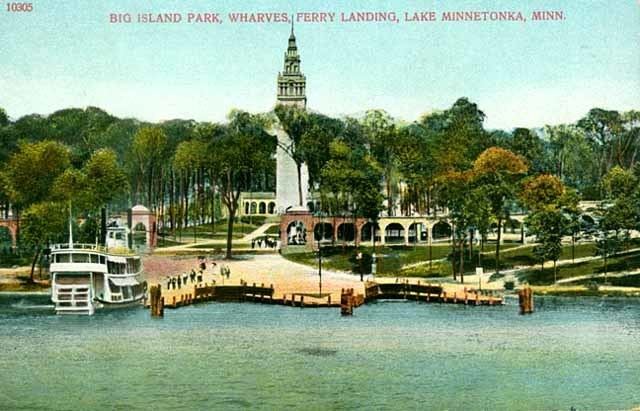 | ||
Big Island Park, commonly referred to as "Big Island Amusement Park," was a popular tourist destination that existed near Minneapolis, Minnesota between 1906 and 1911 on Lake Minnetonka's Big Island. Today the property is a municipal nature park owned by the City of Orono.
Contents
ConceptionEdit
The Twin Cities of Minneapolis-Saint Paul once boasted one of the most extensive streetcar systems in the United States with lines reaching 20 miles in either direction from the downtown area. At its height in the early Twentieth century, lines reached the suburbs of Stillwater in the east and Tonka Bay in the west. The Twin City Rapid Transit Company (TCRT), which owned and operated the system, announced in 1905 that it had plans to purchase 65 acres (260,000 m2) of land on Lake Minnetonka's Big Island near the suburb of Excelsior and build on the premises a grand amusement park. The announcement was part of TCRT Chairman Thomas Lowry's master plan to attract tourists and excursionists to the edge of the system on summer weekends, when ridership was typically low. The company was already operating another amusement park called Wildwood near the eastern end of the system on White Bear Lake.
Big Island Park opened on August 5, 1906 with construction still underway.
AmenitiesEdit
A total of 10,000 or more persons typically visited Big Island Park each weekend with good weather. Since Big Island Park was located on an island, TCRT had to build three 1,000-passenger ferry boats and a transfer terminal in Excelsior to efficiently carry the visitors to and from mainland. Each of the ferries were 108 feet (33 m) long and were double-ended so that they didn't have to turn around after each crossing. TCRT's Express Boats also provided limited service to Big Island Park, but only on rare occasions.
To lodge overnight visitors, TCRT purchased the dilapidated Lake Park Hotel in Tonka Bay, renovated it, and reopened it as the Tonka Bay Hotel.
TCRT had boldly commissioned Leroy Buffington, a renowned local architect, to design Big Island Park's structures in the Mission Revival style of architecture. Many of the park's buildings, including a 186-foot (57 m) light beacon modeled after the Tower of Seville, were lit with electric lights as well. The light cast from the top of the beacon could allegedly be spotted from downtown Minneapolis on a clear night, approximately 15 miles away.
A 1,500-seat music casino was completed in 1907 to serve as the park's premier entertainment center. Among the biggest acts to perform at the casino were the New York band and orchestra of Frederick Innes and the Banda Rossa Orchestra under the direction Eugenio Sorrentino. Most headliners, however, were local.
Other attractions at Big Island Park included a roller coaster, a carousel, boat rentals, a log flume-type ride called the Old Mill, and another ride called the Scenic Ride to Yellowstone Park. The park was also known for its fine picnic grounds.
ClosureEdit
Due to tremendous operating costs and lack of revenue during the off season, TCRT closed Big Island Park in August 1911 and abandoned the property shortly thereafter. Most of the buildings and rides were dismantled over the winter of 1917-1918. Rebar within the structures was smelted down and used for the World War I effort.
Big Island Park TodayEdit
The property was eventually sold to several veteran associations in the 1920s and used as a campground for nearly 80 years. The City of Orono purchased the property after the campground closed in 2003 and reopened it as a municipal nature park in 2006. Today virtually nothing of the original amusement park remains except for several foundations, a ditch that once contained the Old Mill ride, and the remains of the grand entrance, also referred to as "The Mall." Camping and alcohol are not allowed on the premises, but picnics, hiking, and other recreational activities are encouraged. A public dock is located at the site of the original steamboat wharf.
Orono Community Education, with support from the Jeffers Foundation, established Big Island's first and only school in 2006, the Big Island Summer Institute. The program was forced to relocate, however, after fire destroyed the facility in 2011.
